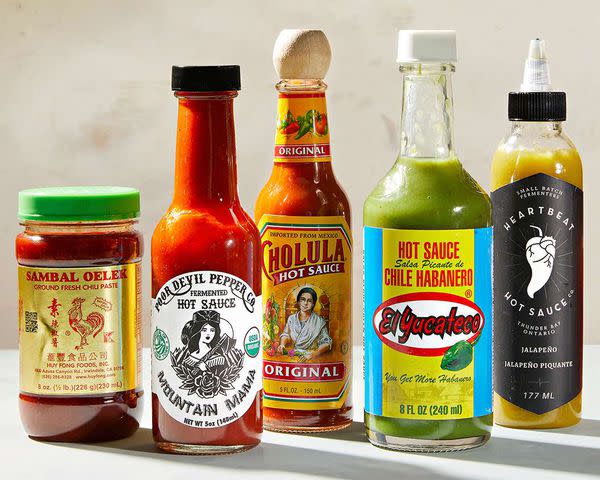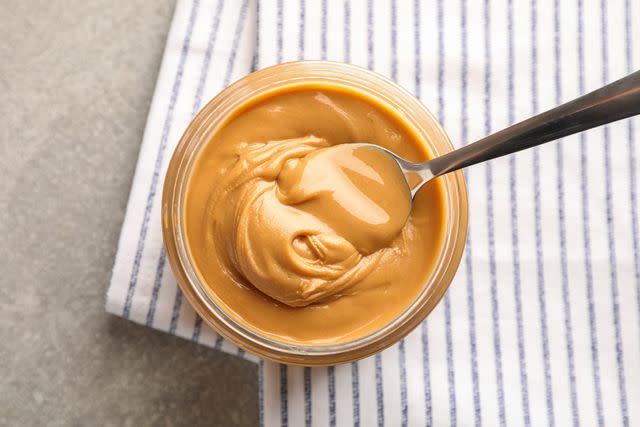8 Foods You Aren't Refrigerating—but Definitely Should
Learn which common foods to move from your pantry into your fridge.

When you come home from the grocery store, one of the first things you do is put away the foods that live in the fridge. Eggs, milk, and butter quick are quickly returned back into the chill to ensure safety and increase longevity. But what about items like almond butter or the packaged tortillas for taco night? As it turns out, there might be a few foods that wind up in your pantry when they should really be in your fridge.
It's important to identify the items you might be storing incorrectly. "Never challenge nature, and store products correctly as soon as you buy or harvest them," says Yannick Tirbois, culinary instructor at Le Cordon Bleu. Certain foods that contain high amounts of water, sugar, fat, and protein and also have low acidity or salt concentrations can quickly spoil from yeast, mold, and bacteria, adds food scientist Bryan Quoc Le, Ph.D.

It's also key to take note of any foods that were not refrigerated when you bought them, but should be after they are opened. Items like salad dressing and tomato sauce can be stored stored at room temperature on a pantry shelf, but shouldn't be returned there after that seal is broken. At that point, give them their rightful place in your fridge.
Ahead, Le, Tirbois, and Katie Macarelli from Natural Grocers share the common foods you probably aren't refrigerating, but should.
Related: Food Storage Mistakes to Avoid
Foods You Should Always Refrigerate
The U.S. Department of Agriculture (USDA) estimates that about 30 to 40 percent of all food in the U.S. goes to waste annually, costing a family of four as much as $1,500 per year and contributing to the climate crisis. It's time to reverse that trend and save yourself some money by storing foods properly. Here are some of the most common foods that you might not realize should be stored in the refrigerator.
Hot Sauce

Hot sauce is a big category. How you store it really comes down to what the hot sauce is made from and how quickly you plan to consume it. If it happens to contain cream or eggs, which some homemade hot sauces do, it needs to be in the fridge, says Tirbois. For other hot sauces, even those made with vinegar, storing it in your pantry likely won't lead to food safety issues, but you'll want to refrigerate your favorite hot sauce after opening to preserve its flavor and prevent it from spoiling. Le says that hot sauces can suffer spoilage after one to two months unless they are fermented or contain high levels of salt.
"For example, Tabasco can last for up to six months outside of the refrigerator for optimum quality, and can still keep its kick for several years," says Le. "That's because Tabasco goes through a special aging process where the chili mash is salted and kept in oak barrels for three years, which reduces the concentration of available sugars and other nutrients while at the same time creating a microbiological environment that preserves the sauce."
Unless you want to spend a lot of time reading your hot sauce labels, the safest way to keep your sauce fresh and with its usual flavor punch is to store it in the fridge.
Ketchup
There's a lot of debate around whether or not ketchup should be kept in the refrigerator after it is opened. According to Le, there is little risk that ketchup will harbor harmful microorganisms due to its acidity if it is stored at room temperature—but he recommends keeping it in the fridge. "It is best to keep it refrigerated after opening because ketchup contains sugar and the acidity isn't so high that it prevents the growth of spoilage microorganisms," he says. "Yeast and mold can easily infect the ketchup and result in changes in flavor."
Maple Syrup
Maple syrup doesn't contain preservatives and should be refrigerated once opened. "The water content is high enough for yeasts to grow and spoil the syrup," Le says. Sugar may crystallize around the neck of the container even when the syrup is refrigerated, but don't worry—this is not a sign of spoilage—it just might make the bottle harder to open.
Mustard
If you consume mustard within a month or so of opening a jar, go ahead and keep it at room temperature. Otherwise, store it in the fridge. "Mustard doesn't contain as much sugar as ketchup, so it can be kept outside of the refrigerator for about one to two months before it spoils," says Le. Like with other foods, storing mustard in the refrigerator will also preserve its quality.
Nuts and Seeds
"Nuts and seeds have a higher oil content and can go rancid faster at room temperature," says Macarelli. Store them in a cool, dark place, like your pantry, if you use them up fast; otherwise, to preserve freshness pop them in the refrigerator—or stash them in the freezer for longer-term storage. Remember that whole, unshelled nuts will stay fresh longer than shelled, chopped ones.
Nut Butters

Whether you prefer almond or peanut butter, your nut butter can be stored at room temperature when unopened. Once opened, the oil can start to separate and turn rancid; this is especially true for natural nut butters (those without added preservatives).
If you have an opened jar in your pantry, don't worry—there's no need to toss it unless it's been there for months, Macarelli says. Once opened, most natural nut butters will stay fresh to use in a pantry for up to a month; nut butters with preservatives will last for two to three months unrefrigerated.
Tortillas

Not sure how to store tortillas? Prevent them from going stale before your next Taco Tuesday by storing them in the fridge. They can quickly turn moldy if left at room temperature, says Le.
Whole Wheat and Other Stone-Milled Flour
Unlike all-purpose flour, whole wheat and other small-batch flours that are stone milled contain germ and bran. This means that, like nuts and nut butters, they are rich in natural oils that can turn rancid over time. At Natural Grocers, they refrigerate flour (as well as nuts and seeds) to maintain peak freshness for their customers, says Macarelli.
At home, keep whole wheat and other small-batch flours fresh by transferring them from their original packaging to an airtight container you store in the fridge. Like with other refrigerated ingredients, bring these flours to room temperature before using them for baking.

